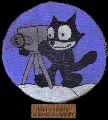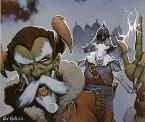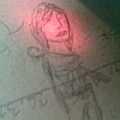Lowpe
Posts: 22133
Joined: 2/25/2013
Status: offline

|
Here is another of my fights. Fighters were set to 50% CAP, and this is the second battle of the day fighting from a damaged runway.
The interesting thing here is the Allies sweeping at 10K, my patrol altitude is 7K and 9K, but the air controllers routed the CAP very high...which makes it seem to me that this was a climbing dogfight and the Airacobra, lacking superchargers, took it on the chin as we out climbed the Allies.
Morning Air attack on Coal Harbour , at 204,49
Weather in hex: Clear sky
Raid detected at 11 NM, estimated altitude 13,000 feet.
Estimated time to target is 3 minutes
Japanese aircraft
A6M2 Zero x 14
A6M5 Zero x 8
Ki-43-IIb Oscar x 38
Ki-44-IIa Tojo x 20
Allied aircraft
P-39D Airacobra x 24
Japanese aircraft losses
Ki-43-IIb Oscar: 1 destroyed
Ki-44-IIa Tojo: 1 destroyed
Allied aircraft losses
P-39D Airacobra: 6 destroyed
CAP engaged:
Shoho-1/C with A6M5 Zero (0 airborne, 0 on standby, 0 scrambling)
4 plane(s) not yet engaged, 0 being recalled, 1 out of immediate contact.
Group patrol altitude is 9000 , scrambling fighters between 16000 and 21000.
Time for all group planes to reach interception is 42 minutes
Kamikawa Maru-1 with A6M5 Zero (0 airborne, 0 on standby, 0 scrambling)
3 plane(s) not yet engaged, 0 being recalled, 0 out of immediate contact.
Group patrol altitude is 9000 , scrambling fighters between 9000 and 16000.
Time for all group planes to reach interception is 26 minutes
33rd Sentai with Ki-43-IIb Oscar (0 airborne, 0 on standby, 7 scrambling)
14 plane(s) not yet engaged, 0 being recalled, 0 out of immediate contact.
Group patrol altitude is 7000 , scrambling fighters between 9000 and 24000.
Time for all group planes to reach interception is 37 minutes
85th Sentai with Ki-44-IIa Tojo (0 airborne, 0 on standby, 4 scrambling)
12 plane(s) not yet engaged, 1 being recalled, 3 out of immediate contact.
Group patrol altitude is 9000 , scrambling fighters between 6000 and 21000.
Time for all group planes to reach interception is 43 minutes
203rd Sentai with Ki-43-IIb Oscar (0 airborne, 0 on standby, 4 scrambling)
10 plane(s) not yet engaged, 3 being recalled, 0 out of immediate contact.
Group patrol altitude is 9000 , scrambling fighters between 9000 and 22000.
Time for all group planes to reach interception is 36 minutes
12th Ku S-1 with A6M2 Zero (1 airborne, 1 on standby, 0 scrambling)
1 plane(s) intercepting now.
3 plane(s) not yet engaged, 0 being recalled, 2 out of immediate contact.
Group patrol altitude is 7000 , scrambling fighters between 10000 and 18000.
Time for all group planes to reach interception is 40 minutes
15th Ku S-1 with A6M2 Zero (0 airborne, 0 on standby, 0 scrambling)
6 plane(s) not yet engaged, 1 being recalled, 0 out of immediate contact.
Group patrol altitude is 7000 , scrambling fighters between 17345 and 25000.
Time for all group planes to reach interception is 24 minutes
< Message edited by Lowpe -- 4/6/2016 9:16:43 PM >
|
 Printable Version
Printable Version



















 New Messages
New Messages No New Messages
No New Messages Hot Topic w/ New Messages
Hot Topic w/ New Messages Hot Topic w/o New Messages
Hot Topic w/o New Messages Locked w/ New Messages
Locked w/ New Messages Locked w/o New Messages
Locked w/o New Messages Post New Thread
Post New Thread